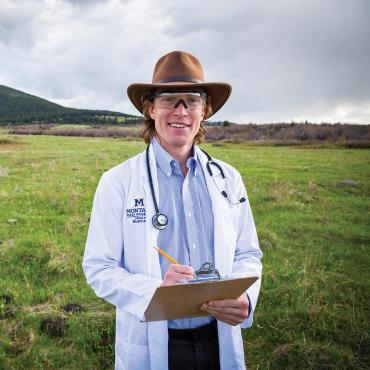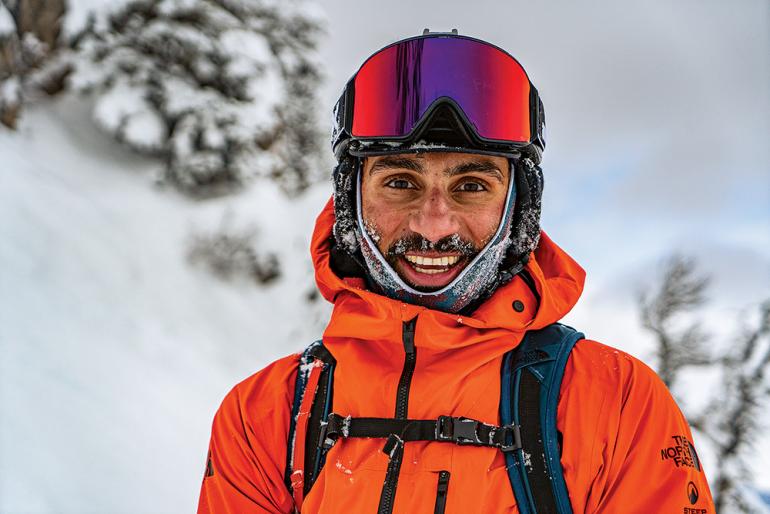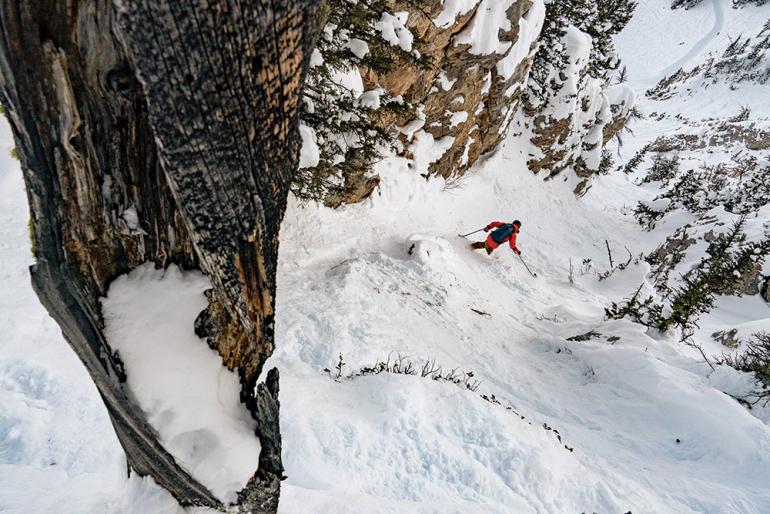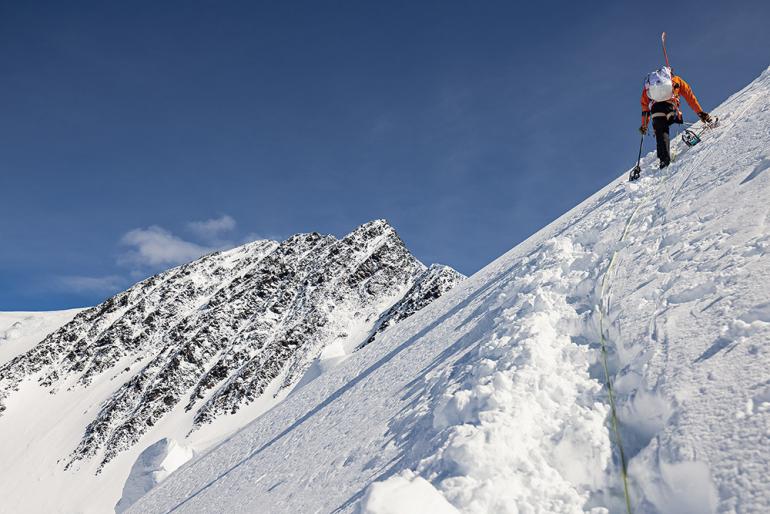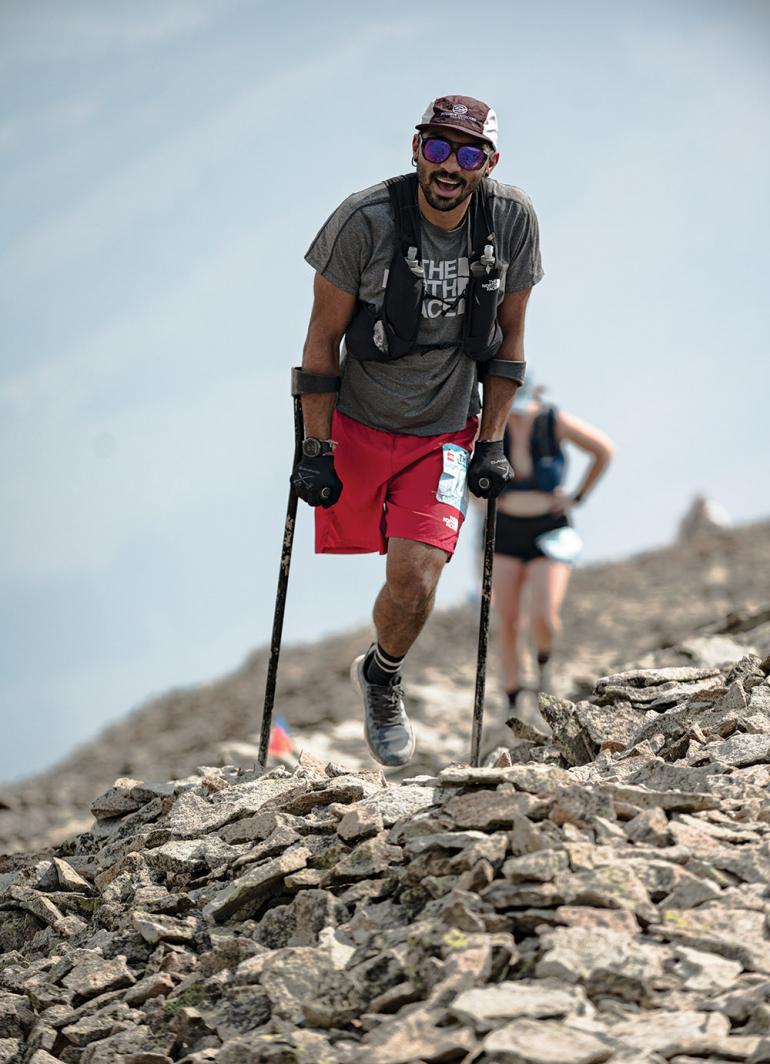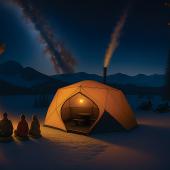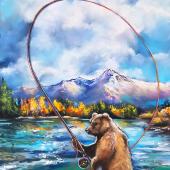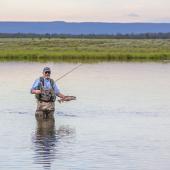Confronting and vanquishing personal limits with Vasu Sojitra.
In many a western mountain town, where steep faces and deep snow collide with social-media-crazed megalomaniacal personalities, folks take great pride in their physical abilities. Bozeman is no exception: here, you’ll find droves of mountain athletes with 10k-plus followers on Insta, tackling big objectives in the mountains, touting their feats as products of determination, fitness, and expertise. It’s good to feel proud, but for all the credit we give ourselves, we often lose sight of the people who’ve helped us along the way. Likewise, we take our abilities for granted, and we feel insecure when confronted with our limitations. Our knee-jerk reaction is to bury this insecurity under a facade of glorified images and statements, inevitably compounding the issue. But a rare few souls are out there to showcase what’s possible when we come to terms with our limits and lean on each other for support, providing a sense of pride that transcends our own psyches. One of those souls is Vasu Sojitra.
You may have seen Vasu skiing at Bridger; his brightly-colored jackets aren’t the only reason he’s hard to miss. From afar, nothing looks out of the ordinary—just another guy ripping down Colter’s, hootin’ and hollerin’. As he skis into South Bowl, something is different. It’s a deep day, but not that deep... How is this guy getting face shots on every turn? And where the heck is his other ski?
If you ran into Vasu in town, he’d look like any other 30-year-old guy hangin’ out around here—North Face coat, cuffed jeans, beat up Vans—someone you’d think spends much of his time on steep snowy slopes or tied into a rope, chasing powder and seeking summits. And if you thought that about Vasu, you’d be right. But a couple things distinguish him from the crowd: for one, his darker skin, and even more so, the absence of his right leg.
Vasu was born in Connecticut to parents who migrated from India. When he was nine months old, he was diagnosed with septicemia—a bacterial infection of the bloodstream that resulted in amputation of his right leg just below the hip. Following this procedure, he, his parents, and his older brother moved to Gujarat, India, where extended family could provide more support. They moved back to Connecticut when he was seven years old, and three years later, he took up skiing at Ski Sundown, a local “mountain” with 16 trails and 600 vertical feet. Vasu fell in love with skiing—we all know the feeling—and went to college at the University of Vermont for better access to ski areas. When he graduated, he headed west in search of cold smoke and found it in Bozeman, where he’s been ever since.
Not only is Vasu exemplifying what’s possible for mountain athletes, regardless of circumstance, he’s also working every day to get more people outside and recreating in the mountains.
Despite his setbacks early in life, Vasu’s narrative of a powder-seeking pilgrimage is common around these parts. His full story exemplifies what’s possible when those attributes of determination, fitness, and expertise are met by humility, self-acceptance, and a willingness to ask for help. Vasu is thoughtfully critical of the individualistic, conceited mindset that runs through the streets of mountain towns, because he knows firsthand how limiting this mindset can be. “Yes, autonomy is great—I don’t ever want someone to tell me how to live my life,” he allows. “But I also want to make sure that when I’m living my life, I’m not just focusing on myself. I’m focusing on uplifting others as much as possible.”
While it’s easy to praise reciprocity, Vasu emphasizes the challenge of putting it into practice. One such moment of reckoning came on a trip to Denali in June of 2021, where he’d traveled with a team of five other skiers, including one fellow lower-limb amputee, Pete McAfee. Their goal was to climb the West Buttress and ski down, making Vasu and Pete the first adaptive athletes ever to do so. Vasu knew that he wouldn’t be able to move as quickly or pull as much weight, and he paced himself wisely. “Even though I hadn’t been to that altitude, I know that 20,000 feet isn’t made for humans,” he says. But when skis hit the snow on the Kahiltna Glacier airstrip, egos began to flourish. “There was definitely some bootstrap-grit mentality early on,” Vasu recalls. And on a couple occasions, some of his teammates may have pushed it too far.
|
|
“It’s hard to judge our own abilities, and we tend to overjudge our confidence,” Vasu reflects. “Especially in unfamiliar situations. It happens to all of us.” But after a few close calls, Vasu saw where he could bring something to the table. “Half the battle is emotional. And when you’re on a month-long expedition, you can’t run away from it. And suppressing it just causes more issues—it’ll manifest in some other way.” He found an opportunity to lead by example, shamelessly accepting assistance in pulling the physical weight, and tasking himself with pulling the emotional weight. “I just tried to have a more calming demeanor, and talk about these uncomfortable issues more openly,” he recalls. “We redistributed where we had strengths and weaknesses. Not as non-disabled people helping disabled people, but just as six of us, out there together. Everyone needs help here and there—that happens on any trip. And no one should judge you for that.”
After three weeks on the mountain, often hunkering down as storms bombarded their camp, all six team members stood on the summit and skied down safely, making history for adaptive athletes. But to Vasu, the real success of the trip was developing a sense of camaraderie among a patchwork of teammates with varying backgrounds and skills. “We’re so stuck on these ‘firsts’ and ‘fastest known times,’ but the point is that we’re reaching these summits because of the massive amount of support we’ve received, and the amount of grit and resiliency we’ve created within ourselves. We’re showcasing what’s possible when people are supported, and in the end, we all realized what it actually means to put something into practice, rather than just talking about it.”
Not only is Vasu exemplifying what’s possible for mountain athletes, regardless of circumstance, he’s also working every day to get more people outside and recreating in the mountains. “Whether it’s through athleticism, or media, or consulting behind the scenes, it’s all just to focus on getting more folks out there, reconnecting with nature. Because we’ve disconnected so, so far away from it,” he says. Vasu works with organizations like Eagle Mount, Teton Adaptive Sports, and the Inclusive Outdoors Project to develop accessible programs and expand their reach. “Most of it is relationship-building. Humans are relational beings—we need to be around other people, and be around nature. And the more we start disconnecting, the more we disembody ourselves.” On a recent trip to Ecuador, where Vasu reached the 19,347-foot summit of Cotopaxi alongside seven other amputee climbers, he was inspired by the locals who seemed not to give a damn about requisites for mountaineering. “People were just crushing it in tennis shoes, up there with schoolbags and reused Dasani water bottles. Not really abiding by the outdoor-industry complex that says you have to look a certain way to do certain things. Screw that.”
After three weeks on the mountain, often hunkering down as storms bombarded their camp, all six team members stood on the summit and skied down safely, making history for adaptive athletes.
He was also inspired by one of his guides, Karl Egloff, an Ecuadorian ultra-runner who’s been quietly shattering records across the globe. “Karl is super unknown, but in Ecuador, everyone knows he’s a badass athlete. He’s put down speed records on four of the Seven Summits. The outdoor industry is mostly defined by European and American standards, but Karl is probably the best ultra-runner in the world.” To challenge the standards of ultra-running himself, Vasu signed up for the Rut this past September and finished the 28k course with a glaring smile on his face. “I was at the back with lay people from the flatlands, people doing their first Rut, and just trying to finish, and that was cool to be around. I’m actually around people that are, well... normal. Not freaks of nature in the outdoors.” Vasu even found a way to leverage his visible disability as a morale boost for other racers. “I was cracking jokes like, ‘good thing I only have one leg, or else I’d be twice as sore!’ Just to get people laughing a little bit, even at 10,000-plus feet up Bone Crusher Ridge.” It’s a good joke, but let’s be honest, it’s hard to imagine how much soreness Vasu’s leg—and arms—felt after hopping 7,800 vertical feet up and down the scree fields of Lone Peak.
On the surface, one might extrapolate a “make no excuses” punchline out of Vasu’s story. But his essence is richer and more complex. He is strong yet impaired, confident yet vulnerable, open-minded yet firmly opinionated. He’s not afraid of confrontation or contradiction, and he thrives off insightful discourse on topics from outdoor accessibility to specialty mountain equipment. It’s a treat just to have a conversation with him, whether you’re lolling over the deep snow at Bridger or going down a rabbit-hole on human social behaviors. He shows us that mountain culture can be more than a self-fulfilling pursuit; that validating each other, warts and all, will fulfill us more than any summit or ski line ever could. So next time you see this guy “ninja-sticking” off the Ridge, stop and have a chat. Share a laugh, or offload a grievance. Ask him anything you like; see if you can catch him off-guard. Just don’t hold your breath.
|
|
|

